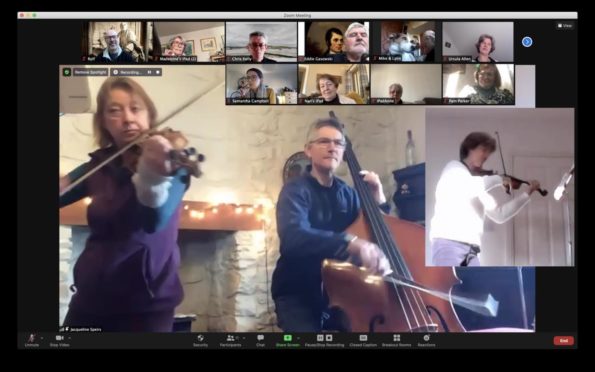A new short film showcasing original music created over Zoom by participants from Tayside aphasia groups has been published on YouTube.
Moving Into The Light is a 30-minute original composition of music and poetry, telling the story of a train journey out of lockdown and around the world.
The film was created by members of Dundee University’s Tap and Talk and Headway Dundee and Angus groups, in collaboration with composer Matilda Brown and Royal Scottish National Orchestra musicians Jacquie Speirs and Ursula Heidecker Allen.
It was made as part of Tayside Healthcare Arts Trust‘s (THAT) ST/ART initiative, which is a creative engagement project for people who have had a stroke or acquired brain injury.
Many of the participants have aphasia, a condition which affects speech and language processing.
The idea behind the collaboration was to explore music as another mode of expressing ideas and emotions.
Composer Matilda explained: “Something about it being music means people know they can express themselves.
“You’ve got this sort of flamboyant composer – me – leading the way and I think that makes people realise that ‘oh I can do it, I’m allowed to do it’.”
Over the course of ten Zoom workshops, Matilda helped the group bring their ideas to life through a series of tailored exercises.
“We started to draw ideas from listening to lots of different kinds of music – from spaghetti western soundtracks to Kate Bush to psychedelic rock – and deciding what that music meant for us.”
“What I think is really important,” Matilda added, “is that we actually made our own melody up together. And that melody features in every single train scene.”
Music in colour
To make composing accessible for all the participants, Matilda ditched traditional scales and lettered notes for colours, assigning a colour to each note on the piano.
She explained: “This way, it’s ‘ok we’ve chosen yellow, it’s this note and this is what it sounds like’.
“So you don’t have to know about the scales and music to know how you’ve made a melody.”
Nan Mitchell, one of the participants from the Tap and Talk Group, admitted she was sceptical at first about how the workshops would translate into a finished product.
“To begin with,” she said, “We all thought ‘this is going to be strange’. Everybody picked different colours, and Matilda said ‘now, we’ll make some music out of this’.
“And we were saying, ‘well how could you make music out of some colours?’ – but it was the notes on a piano, and it was so clever!
“Everybody’s surprised at how it turned out. You don’t have to be a musician to make music.”
Workshops hit all the right notes
THAT project co-ordinator Chris Kelly welcomed the success of the workshops. He said: “The participants felt empowerment being an equal partner with musicians from the RSNO.”
Lynn Strachan, who attends Tap and Talk along with her husband Mike, said the project gave her confidence. She said: “It’s something we’re really proud of. Having to be in the group and actually concentrate on being there has actually helped loads.
“It just builds you up and makes you feel better.”
And Mike, whose piano composition features in the Brechin sequence of the film, was particularly taken aback by the final product.
“I was surprised,” he said, “at my ability to actually produce music.”
Light at the end of the tunnel
Reflecting on the pandemic which served as a backdrop to the project, participant Nan added: “Everybody’s had a difficult year, haven’t they? And this just seemed the nicest thing to do, to make music – you were coming out of a tunnel, into light.”
For Matilda, that hopeful spirit of the group was one of the most challenging and rewarding parts of the composition.
“I quite like dark colours and dark music,” she said. “And the biggest challenge for me was that they steered me out of that to more uplifting music. I would never have written those uplifting pieces if it hadn’t been for them.”
Moving on a new track
Despite the initial difficulties posed by moving the workshop online during lockdown, Tap and Talk facilitator and Dundee University lecturer Rolf Black believes the increased use of video platforms has benefitted the group.
“It’s certainly enable lots of people with a disability to prove suddenly that it is possible – to work from home, for instance, or join a session from home, he said.
“It had to be normalised. By normalising it, you opened up the playing field for many of our participants to join in.”
And Nan added: “You’re not dead just because you’ve got a disability! You can still do things and life has a way of coming up with something else you can achieve.”
